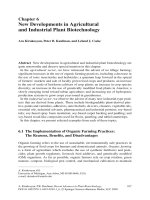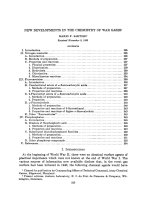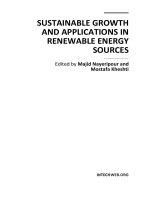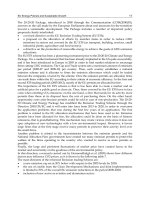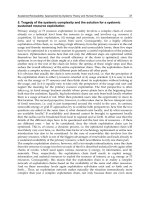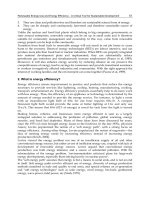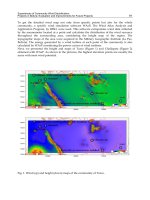NEW DEVELOPMENTS IN RENEWABLE ENERGY pdf
Bạn đang xem bản rút gọn của tài liệu. Xem và tải ngay bản đầy đủ của tài liệu tại đây (19.58 MB, 418 trang )
NEW DEVELOPMENTS IN
RENEWABLE ENERGY
Edited by Hasan Arman and Ibrahim Yuksel
New Developments in Renewable Energy
/>Edited by Hasan Arman and Ibrahim Yuksel
Contributors
Tser Chen, Tsai-Lien Yeh, Yi-Hsuan Ko, A Alolah, Ahmed M. Al Salloum, Mashauri Adam Kusekwa, António Cardoso
Marques, José Alberto Fuinhas, Rui Flora, Pius Olugbenga Fatona, Oladunjoye Abiodun, Adesanwo Adeola, Adetayo
Olumide, Abiodun Abiodun, Mamadou Lamine Doumbia, Gholam Riahy, Sajjad Abedi, Seyed Hossein Hosseinian,
Mehdi Farhadkhani, Wan Azlina Wan Ab Karim Ghani, Ehsan Enferad, Daryoush Nazarpour, Jose Pelegri-Sebastia,
Miguel Pareja Aparicio, Tomás Sogorb, Vicente Llario, Saeid Eslamian, Masoomeh Fakhri, Mohammad Reza Farzaneh,
Ali Eltamaly, Hassan Farh, Robert Peters, Basel I. Ismail, Hasan Arman, Maria Teresa Outeiro, Adriano Carvalho
Published by InTech
Janeza Trdine 9, 51000 Rijeka, Croatia
Copyright © 2013 InTech
All chapters are Open Access distributed under the Creative Commons Attribution 3.0 license, which allows users to
download, copy and build upon published articles even for commercial purposes, as long as the author and publisher
are properly credited, which ensures maximum dissemination and a wider impact of our publications. After this work
has been published by InTech, authors have the right to republish it, in whole or part, in any publication of which they
are the author, and to make other personal use of the work. Any republication, referencing or personal use of the
work must explicitly identify the original source.
Notice
Statements and opinions expressed in the chapters are these of the individual contributors and not necessarily those
of the editors or publisher. No responsibility is accepted for the accuracy of information contained in the published
chapters. The publisher assumes no responsibility for any damage or injury to persons or property arising out of the
use of any materials, instructions, methods or ideas contained in the book.
Publishing Process Manager Iva Lipovic
Technical Editor InTech DTP team
Cover InTech Design team
First published March, 2013
Printed in Croatia
A free online edition of this book is available at www.intechopen.com
Additional hard copies can be obtained from
New Developments in Renewable Energy, Edited by Hasan Arman and Ibrahim Yuksel
p. cm.
ISBN 978-953-51-1040-8
free online editions of InTech
Books and Journals can be found at
www.intechopen.com
Contents
Preface IX
Section 1 Energy Utilization, Conservation and Social Consideration 1
Chapter 1 Present Situation and Future Prospect of Energy Utilization
and Climate Change in Turkey 3
İbrahim Yüksel, Kamil Kaygusuz and Hasan Arman
Chapter 2 Energy Savings Resulting from Installation of an Extensive
Vegetated Roof System on a Campus Building in the
Southeastern United States 21
Robert W. Peters, Ronald D. Sherrod and Matt Winslett
Chapter 3 On the Public Policies Supporting Renewables and Wind Power
Overcapacity: Insights into the European Way Forward 51
António Cardoso Marques, José Alberto Fuinhas and Rui Flora
Chapter 4 Viewing Energy, Poverty and Sustainability in Developing
Countries Through a Gender Lens 83
Pius Fatona, Abiodun Abiodun, Adetayo Olumide, Adesanwo
Adeola and Oladunjoye Abiodun
Section 2 Modeling and Analysis 99
Chapter 5 Improved Stochastic Modeling: An Essential Tool for Power
System Scheduling in the Presence of Uncertain
Renewables 101
Sajjad Abedi, Gholam Hossein Riahy, Seyed Hossein Hosseinian and
Mehdi Farhadkhani
Chapter 6 Modeling of Photovoltaic Cell Using Free Software Application
for Training and Design Circuit in Photovoltaic
Solar Energy 121
Miguel Pareja Aparicio, José Pelegrí-Sebastiá, Tomás Sogorb and
Vicente Llario
Chapter 7 Steady State Modeling of Three Phase Self–Excited Induction
Generator Under Unbalanced/Balanced Conditions 141
A. Alsalloum and A. I. Alolah
Chapter 8 Maximum Power Extraction from Utility-Interfaced Wind
Turbines 159
Ali M. Eltamaly, A. I. Alolah and Hassan M. Farh
Chapter 9 Comparative Analysis of Endowments Effect Renewable
Energy Efficiency Among OECD Countries 193
Tser-Yieth Chen, Tsai-Lien Yeh and Yi Hsuan Ko
Section 3 Wind Power 213
Chapter 10 Wind Speed Regionalization Under Climate Change
Conditions 215
Masoomeh Fakhry, Mohammad Reza Farzaneh, Saeid Eslamian and
Rouzbeh Nazari
Section 4 Biomass 237
Chapter 11 Biomass Conversion to Energy in Tanzania: A Critique 239
Mashauri Adam Kusekwa
Section 5 Ocean Energy 271
Chapter 12 Ocean's Renewable Power and Review of Technologies: Case
Study Waves 273
Ehsan Enferad and Daryoush Nazarpour
Section 6 Geothermal 301
Chapter 13 ORC-Based Geothermal Power Generation and CO2-Based EGS
for Combined Green Power Generation and CO2
Sequestration 303
Basel I. Ismail
ContentsVI
Section 7 Fuel Cell 329
Chapter 14 Methodology of Designing Power Converters for Fuel Cell
Based Systems: A Resonant Approach 331
Maria Teresa Outeiro and Adriano Carvalho
Section 8 Integrated System 363
Chapter 15 Wind Diesel Hybrid Power System with
Hydrogen Storage 365
Mamadou Lamine Doumbia, Karim Belmokhtar and Kodjo
Agbossou
Chapter 16 Sustainable Power Generation Through Co-Combustion of
Agricultural Residues with Coal in Existing Coal
Power Plant 389
Wan Azlina Wan Ab Karim Ghani and Azil Bahari Alias
Contents VII
Preface
Unlike to fossil energy sources, renewable energy sources such as sunlight and wind are
existed in widespread geographical areas of the world and provide important opportunities
for energy efficiency. Higher growth rate in production of renewable energy and technologi‐
cal diversification of energy sources will contribute a significant energy security and sub‐
stantial economic benefits to many nations. Consequently, in developing countries, projects
related to renewable energy can directly contribute to poverty alleviation via providing the
energy needed for setting up businesses and employment. Also, renewable energy technolo‐
gies can make indirect assistances to poverty alleviation by providing energy for cooking,
space heating, and lighting. Renewable energy can also contribute to education by provid‐
ing electricity to schools.
The recent studies indicate that renewable energy sources have been grown at an average
annual rate of 1.7% since 1990s. It is slightly less than the annual growth rate of world's’
Total Primary Energy Supply (TPES) which is 1.9%. Especially, the average annual growth
rate of wind power is the highest with 25%. However, the production still remains small due
to its very low base in 1990s. Most of the production and growth of solar and wind energy
are committed by the Organization for Economic Co-operation and Development (OECD)
countries. With 10.4% of annual growth rate, renewable municipal waste, biogas and liquid
biomass were recorded as the second highest growing energy sources. Having an annual
growth rate of 1.2%, the primary solid biomass is the largest contributor to renewable ener‐
gy in the world and has experienced the slowest growth among the renewable energy
sour‐
ces. Most of the solid biomass is produced in the Nnon-OECD countries, but its growth is
comparable forto OECD and non-OECD countries. The annual growth rate of solar photo‐
voltaics and solar thermal is 9.8%. The average annual growth rate of hydropower in non-
OECD countries (3.7%) was larger than in OECD countries (0.4%) between 1990 and 2007.
Sustainable energy is the provision of energy that meets the needs of the present without
compromising the needs of the future. Renewable energy technologies are important con‐
tributors to sustainable energy which utilize renewable energy sources, such as hydroelec‐
tricity, solar energy, wind energy, wave power, geothermal energy, and tidal power. They
generally contribute to world's energy security by reducing dependence on fossil fuel re‐
sources, improving energy efficiency, and providing opportunities for mitigating green‐
house gases.
Sustainable development has evolved to integrate economic, social and environmental aims.
Sustainable development has emerged as the key challenge for the 21st Ccentury. Both the
opportunities and the lack of progress were highlighted during the Johannesburg World
Summit on Sustainable Development in 2002. Decision-makers are looking for sustainable
development in order to provide practical approaches for addressing traditional issues as
well as the newer challenges.
Energy is important for economical and social development and enhanced quality of life in
all nations. However, if technology were to remain stable and if overall quantities were to
increase substantially, much of the world’s energy could not be sustained under the current
production and consumption ways. There is an urgent need to control atmospheric emis‐
sions of greenhouse and other gases/substances for efficiency in energy production, trans‐
mission, distribution, and consumption in the country. As policymakers and investors all
around the world are aware of the electricity’s critical role in improving living standards
and sustaining economic growth, electricity supply infrastructures in many developing
countries are being rapidly expanded.
The book is divided into nineeight sections;: Energy Utilization, Conservation and Social
Consideration, Modeling and Analysis, Wind Power, Biomass, Ocean Energy, Geothermal,
Bio Fuels, Fuel Cell and Integrated System. Each section has a number of chapters address‐
ing various issues related to renewable energy.
A number of experts have provided progressive contributions for the development of this
book. The editor and Cthe co-editor of the book are thankful for their supportive and con‐
tinuous efforts in completing this book. This book mightwould not be existed if thereit
wasn't for was no their remarkable contributions. Finally, the editors would like to kindly
thank to all InTech peoplestaff for their invitation and enthusiasm from the
first to the fi‐
nal stage of this book.
Editor
Dr. Hasan Arman
Professor, Geology Department
College of Science
United Arab Emirates University
Al Ain, United Arab Emirates
Co-editor
Ibrahim Yuksel
Associate Professor, Civil Engineering
Faculty of Tecnology
Sakarya University
Sakarya, Turkey
PrefaceX
Section 1
Energy Utilization, Conservation and Social
Consideration
Chapter 1
Present Situation and Future Prospect of
Energy Utilization and Climate Change in Turkey
İbrahim Yüksel, Kamil Kaygusuz and Hasan Arman
Additional information is available at the end of the chapter
/>1. Introduction
Sustainable development has emerged as the key challenge for the 21
st
Century. The Johan‐
nesburg World Summit on Sustainable Development in 2002 highlighted both the opportuni‐
ties and the lack of progress since the Earth Summit in Rio de Janeiro, a decade previously.
Decision-makers are looking to sustainable development to provide practical approaches that
could address traditional issues as well as the newer challenges. Although no universally
accepted practical definition of sustainable development exists as yet, the concept has evolved
to integrate economic, social and environmental aims [1,2]. Recent increases in energy prices
are likely to be the precursor of a longer term trend. While they will encourage much needed
energy efficiency and stimulate investment, they pose severe difficulties for expanding access
to modern energy services to the one third of people who still do not have it, or whose access
is inadequate for economic development. An energy system embodying such inequities is
neither sustainable nor acceptable [3].
However, developing the remaining hydropower potential offers many challenges and
pressures from some environmental action groups over its impact has tended to increase over
time. Hydropower throughout the world provides 17% of our electricity from an installed
capacity of some 730 GW is currently under construction, making hydropower by far the most
important renewable energy for electrical power production. The contribution of hydropower,
especially small hydropower (SHP) to the worldwide electrical capacity is more of a similar
scale to the other renewable energy sources (1-2% of total capacity), amounting to about 47
GW (53%) of this capacity is in developing countries [3,4].
Affordable energy services are among the essential ingredients of economic development,
including eradication of extreme poverty as called for in the United Nations Millennium
Development Goal (MDGs). Modern energy services-mainly provided by liquid and gaseous
© 2013 Yüksel et al.; licensee InTech. This is an open access article distributed under the terms of the Creative
Commons Attribution License ( which permits unrestricted use,
distribution, and reproduction in any medium, provided the original work is properly cited.
fuels, as well as electricity-are essential. Convenient, affordable energy is also important for
improving health and education, and for reducing the human labour required to cook and
meet other basic needs [3-6].
Meanwhile, global climate change poses an unprecedented threat to all human beings. While
this problem is important in the long-run, most decision-makers recognise (especially in the
developing countries), that there are many other critical sustainable development issues that
affect human welfare more immediately. However, even in the short term, climate is an
essential resource for development. For example, in many countries (especially the poorest
ones), existing levels of climatic variability and extreme events pose significant risks for
agriculture, economic infrastructure, and vulnerable households. Climatic hazards continue
to take their human and economic toll even in wealthy countries. Such climate threats, which
undermine development prospects today, need to be better addressed in the context of the
long-run evolution of local and regional climates [1,7].
There is a growing concern that long-run sustainable development may be compromised
unless measures are taken to achieve balance between economic, environmental and social
outcomes. Since the early 1980s, Turkish energy policy has concentrated on market liberali‐
zation in an effort to stimulate investment in response to increasing internal energy demand
[8]. Turkey's new government has continued this policy despite lower energy demand induced
by the 2001 economic crisis. On the other hand, CO
2
and other greenhouse gas emissions of
the country are increasing rapidly due to energy and electricity utilization [9].
More generally, climate change and sustainable development interact in a circular fashion.
Climate change vulnerability, impacts and adaptation will influence prospects for sustainable
development, and in turn, alternative development paths will not only determine greenhouse
gas (GHG) emission levels that affect future climate change, but also influence future capacity
to adapt to and mitigate climate change. Impacts of climate change are exacerbated by
development status, adversely affecting especially the poor and vulnerable socio-economic
groups. The capacity to adapt to climate change goes beyond wealth, to other key pre-requisites
of good development planning, including institutions, governance, economic management
and technology [1,10].
The key to an effective climate change response strategy is a better understanding of relevant
policy linkages. Development planners, naturally, place development first, and therefore,
climate policies need to be integrated within national sustainable development strategies. In
particular, they would like to know whether specific climate change impacts and response
measures will make existing development efforts less, or more, sustainable in terms of their
economic, social and environmental dimensions [1].
2. Climate change, energy and emission profile in Turkey
Turkey’s total carbon dioxide (CO
2
) emissions amounted to 239 million tons (Mt) in 2006 (Tables
1-3). Emissions grew by 5% compared to 2001 levels and by just over 50% compared to 1990
New Developments in Renewable Energy4
levels. Oil has historically been the most important source of emissions, followed by coal and
gas. Oil represented 45% of total emissions in 2004, while coal represented 40% and gas 15%. The
contribution of each fuel has however changed significantly owing to the increasingly impor‐
tant role of gas in the country’s fuel mix starting from the mid-1980s [3,11,12].
1990 1995 2000 2002 2004 2006
CO
2
sectoral approach (Mt of CO
2
) 126.91 152.66 200.56 202.13 2007.25 239.74
CO
2
reference approach (Mt of CO
2
) 138.20 157.28 203.48 203.45 209.50 242.61
Total Primary Energy Supply, TPES (Mtoe) 52.94 61.81 76.87 78.73 81.83 94.00
GDP (billion 2000 US$ using PPPs) 309.57 362.57 439.99 464.79 506.30 576.82
Population (millions) 56.20 61.64 67.46 70.71 71.79 72.97
CO
2
/ TPES (t CO
2
per TJ) 57.30 59.00 62.30 61.30 60.50 60.90
CO
2
/GDP (kg CO
2
per 2000 US$) 0.91 0.93 1.01 0.96 0.90 0.92
CO
2
/ GDP (kg CO
2
per 2000 US$ PPP) 0.41 0.42 0.46 0.43 0.41 0.42
CO
2
/ population (t CO
2
per capita) 2.26 2.48 2.97 2.86 2.89 3.29
Table 1. Key indicators in Turkey [3,13].
CO
2
emissions Level assessment Cumulative
IPCC source category (Mt of CO
2
) (%) total (%)
Production electricity and heat-coal/peat 42.32 12.6 12.6
Manufacturing industries-coal/peat 42.30 12.6 25.1
Road-oil 36.60 10.9 36.0
Production electricity and heat-gas 27.28 8.1 44.1
Residential-gas 14.45 4.3 48.4
Manufacturing industries-oil 12.35 3.7 52.0
Residential-coal/peat 10.10 3.0 55.0
Non-specified other sectors-oil 9.69 2.9 57.9
Manufacturing industries-gas 8.01 2.4 60.3
Non-specified other sectors-gas 6.51 1.9 62.2
Other transport-oil 5.36 1.6 63.8
Total CO
2
from fuel combustion 239.74 71.1 71.1
Table 2. Key sources for CO
2
emissions from fuel combustion for Turkey in 2006 [3,14].
Present Situation and Future Prospect of Energy Utilization and Climate Change in Turkey
/>5
Years CO
2
CH
4
N
2
O F gases Total
1990 139.6 29.2 1.3 0.0 170.1
1992 152.9 36.7 4.0 0.0 193.6
1994 159.1 39.2 2.2 0.0 200.5
1996 190.7 45.0 6.1 0.4 242.1
1998 202.7 47.7 5.6 0.7 256.6
2000 223.8 49.3 5.8 1.1 280.0
2002 216.4 46.9 5.4 1.9 270.6
2004 241.9 46.3 5.5 2.9 296.6
2005 256.3 49.4 3.4 3.2 312.4
Table 3. Greenhouse gas emissions by gas in Turkey (million tons CO
2
eq) [3,13,14].
According to recent projections, total primary energy supply (TPES) will almost double
between 2006 and 2020, with coal accounting for an increasingly important share, rising from
24% in 2006 to 36% in 2020, principally replacing oil, which is expected to drop from 40% to
27%. Such trends will lead to a significant rise in CO
2
emissions, which are projected to reach
nearly 600 Mt in 2020, over three times 2004 levels [3,12,14,15].
In 2006, public electricity and heat production were the largest contributors of CO
2
emissions,
accounting for 30% of the country’s total. The industry sector was the second largest, repre‐
senting 28% of total emissions, followed by transport, which represented 20% and direct fossil
fuel use in the residential sector with 8%. Other sectors, including other energy industries,
account for 14% of total emissions. Since 1990, emissions from public electricity and heat
production have grown more rapidly than in other sectors, increasing by 6%. Simultaneously,
the shares of emissions from the residential and transport sectors both dropped by 7% and 3%
respectively while the share of emissions from the manufacturing industries and construction
sector remained stable [3,11,13,16].
Over 40% of all energy is used by the industrial sector and nearly 35% in the residential sector.
The rest is split between transportation and commercial services. Industry in Turkey is energy
intensive, especially iron and steel manufacturing and cement production sectors, by far the
largest energy users. In the residential and commercial building sector, more than 80% of
energy is used for space heating. Use of electrical appliances is rapidly increasing and boosting
power demand. Table 4 shows the electric power capacity development in Turkey. Increasing
use of air-conditioning, especially in the Mediterranean region, has shifted the peak hours of
electricity demand to noon in the summer. Electricity consumption for lighting accounts for
30-40% of power consumption in the residential sector.
New Developments in Renewable Energy6
Fuel type
2005 2010 2020
Installed
capacity (MW
e
)
Generation
(GWh)
Installed
capacity
(MW
e
)
Generation
(GWh)
Installed
capacity
(MW
e
)
Generation
(GWh)
Coal 14465 48386 16106 104040 26906 174235
Natural gas 10756 66417 18923 125549 34256 225648
Fuel oil 2124 10531 3246 18213 8025 49842
Renewables 14112 50900 25102 86120 30040 104110
Nuclear 0.0 0.0 2000 14000 10000 70000
Total 41457 176234 65377 347922 109227 623835
Table 4. Electric power capacity development in Turkey [11].
On the other hand, the transport sector is dominated by road transport. Vehicle ownership is
only seven vehicles per hundred inhabitants compared to the OECD average of fifty. Capacity
utilization of available rail lines for passenger transport is low for inter-city traffic and higher
for suburban lines [3,17-20].
3. Climate change and greenhouse gas emissions policies in Turkey
Turkey was a member of the OECD when the United Nation Framework Convention on
Climate Changes (UNFCCC) was adopted in 1992, and was therefore included among the so-
called Annex I and Annex II countries. Under the convention, Annex I countries have to take
steps to reduce emissions and Annex II countries have to take steps to provide financial and
technical assistance to developing countries. However, in comparison to other countries
included in these annexes, Turkey was at a relatively early stage of industrialization and had
a lower level of economic development as well as a lower means to assist developing countries.
Turkey was not given a quantified emissions reduction or limitation objective in the Kyoto
Protocol. Following a number of negotiations, in 2001 Turkey was finally removed from the
list of Annex II countries but remained on the list of Annex I countries with an accompanying
footnote specifying that Turkey should enjoy favorable conditions considering differentiated
responsibilities. This led to an official acceptance of the UNFCCC by the Turkish Grand
National Assembly in October 2003, followed by its enactment in May 2004. Turkey has not
yet signed the Kyoto Protocol [3,11,14,21].
Present Situation and Future Prospect of Energy Utilization and Climate Change in Turkey
/>7
Throughout this process, the government carried out a number of studies on the implications
of climate change and its mitigation. The first efforts were undertaken by the National Climate
Coordination Group in preparation for the 1992 Rio Earth Summit. Following this, a National
Climate Program was developed in the scope of the UNFCCC. In 1999, a specialized Com‐
mission on Climate Change was established by State Planning Organization (DPT) in prepa‐
ration of the Eighth Five-Year Development Plan (2001-2005). The Five-Year Development Plan
was the first planning document to contain proposals for national policies and measures to
reduce GHG emissions, and funding for climate-friendly technologies [3,22].
Following the ratification of the UNFCCC, a number of working groups were set up with the
objective to define a climate change mitigation strategy and compile the country’s first national
communication to the UNFCCC. These included a working group on mitigation in the energy
sector and a working group on mitigation in the transport sector. However, it remains unclear
as to when the strategy and national communication will be completed. The strategy aims to
reduce GHG emissions through the implementation of appropriate measures and the devel‐
opment of climate-friendly technologies. Energy efficiency and the development of renewable
energy sources are two important components of the strategy. However, the strategy will not
include any policies that directly target GHG emissions, such as carbon taxation or emissions
trading. It also does not include a specific target for emissions reductions [3,14].
4. Global warming and environmental policy in Turkey
Developing countries, while varying in size and population, political system, economic
structure, bear many similarities. They are facing less favourable economic circumstances,
worsening environmental degradation and challenges in curbing climate changes. The present
paper [1] only focuses on the issues of contradictory objectives, unrealistic standards and
limited public participation.
Policy makers in developing countries are well aware of the importance of environmental
protection. However, more often than not, they are placed in a dilemma when left to balance
between economic growth and environment. Conflicts often rise between social, environmen‐
tal and economic objectives [1,23]. The headlong pursuit of economic growth is the cornerstone
of developing countries. A top Turkish environmental official accepted that economic growth
must take precedence over environmental protection for years to come because the former is
not only of great importance to maintaining political stability but also to funding the environ‐
mental clean-up. This very contradictory objective in developing countries is well materialized
in the implementation of “Polluter Pays Principles” (the PPP), the value of which is dramati‐
cally belabored. A good example can be found in the way the governments deal with state-
owned enterprises (SOEs) in emissions abatement.
On the other hand, for developing countries, great importance should be attached to the
acceleration of environmentally responsible development rather than following the past, and
arguably the present, path of the industrial world in pursuit of “unrestricted economic growth
without considerations to its effects on the natural environment”.
New Developments in Renewable Energy8
Public unawareness of environmental impacts presents a serious impediment in developing
countries to effectively implementing environmental policies. Frequently decisions are made
in the absence of environmental information in these countries [1,23]. In addition, environ‐
mental impacts are normally exposed to the purview of selected environmental departments,
and offices in charge, and expert researchers. The public tend to be left in the dark about the
seriousness of the worsening environment they are living in, the costs to their health and
quality of life, and the opportunity of helping policy-makers to improve the environment. The
lack of environmental awareness has resulted in indifference to environmental degradation,
an absence of self-regulating motivation and, above all, a lack of enthusiasm to be involved in
monitoring polluting operations and enterprises. Public participation could be a cost-effective
method of implementing environmental policy, especially for those countries chronically short
of funds and trained human resources.
Since possible results of the global warmth gradually started to form the most basic problem
on environmental basis, “Framework Convention on Climate Changes” (FCCC) is constituted
which was due on March 21, 1994 followed by its approval by 50 countries after being first
approved in Rio Environment and Development Conference held in 1992. Aim of the Con‐
vention is to keep the concentration of greenhouse gas in the atmosphere at a constant level
necessary to prevent its hazardous man caused impact on climate system. On the other hand,
international society will come to a common decision in Conference of Parties (COP) held
annually where all participating countries are closely involved in decision making process.
The countries in Convention’s Appendix-1 list decided by Kyoto Protocol to be due between
2008 and 2012 will be forced to reduce total emission level of gases (CO
2
, CH
4
, N
2
O, HFC
s
) that
have direct greenhouse effect 5% below the level in 1990 [1,24].
5. Electricity generation and CO
2
emission in Turkey
The electricity generation in Turkey is dominated by fossil fuels. As shown in Fig. 1, the share
of fossil fuels in total generation has been steadily increasing for last two decades and reached
to the peak share of 82,5% in 2008 [25]. The 57,4% of total electricity generation in 2008 was
from imported fuels (natural gas, imported coal and liquid fuels). The high level of fossil fuel
dependency in the electricity generation is the major cause of increase in the national GHG
emissions. Since 1990, the total GHG emission of Turkey has increased more than twofold and
reached 366,5 million tons of CO
2
e in 2008. Within the same period, the GHG emissions
generated upon the electricity generation is increased more than threefold from 30 million tons
in 1990 to 101,4 million tons in 2008 [9].
Turkey’s GHG emissions were doubled by 2008 and reached to 366,5 million tons CO
2
e
comparing 1990 level as shown in Fig. 2 [9]. In 2008, around 80% of the total emissions of Turkey
were from CO
2
while one third of CO
2
emissions were from electricity generation as shown in
Fig. 3 [9]. In other words, more than one quarter of total emissions (27%) are due to electricity
generation by fossil fuels. Other important CO
2
sources are industry, road transportation,
residential and cement production [9].
Present Situation and Future Prospect of Energy Utilization and Climate Change in Turkey
/>9
Figure 1. Share of fossil fuels in electricity generation of Turkey by years (%).
Figure 2. Development of cumulative GHG emissions of Turkey by years.
New Developments in Renewable Energy10
Figure 3. Development of total and electricity generation CO
2
emissions by years in Turkey.
6. Hydropower as a renewable energy in Turkey
Turkey has substantial renewable energy resources. Renewables make the second-largest
contribution to domestic energy production after coal. In 2003, energy from renewable sources
amounted to 10 Million tons of oil equivalent (Mtoe). More than half of renewables used in
Turkey are composed of combustible renewables and waste, the rest being mainly hydro and
geothermal as shown in Table 5. Combustible renewables and waste used in Turkey are almost
exclusively non-commercial fuels, typically wood and animal products, used in the residential
sector for heating. The use of biomass for residential heating, however, has declined owing to
replacement of non-commercial fuels by commercial fuels. The contribution of wind and solar
is still small but is expected to increase. Electricity generation from renewables totalled 35.5
TWh and contributed 25% to total generation in 2004. In 1990, generation from renewables was
23.2 TWh and their share in power generation was higher, representing 40%. Hydro is the
dominant source of renewable electricity, with only 0.15 TWh derived from other sources.
Hydro production fluctuates annually depending on the weather [3,12,15,26-28].
Hydropower generation climbed from 2 Mtoe (23.1 TWh) in 1990 to 3.0 Mtoe (35.3 TWh) in 2004,
growing on average by 3.8% per year. The economic hydropower potential has been estimat‐
ed at 128 TWh per year, of which 35% has been exploited. The government has a strategy for
developing the hydropower potential and expects a few hundred plants to be constructed over
the long term adding more than 19 GW of capacity. Construction costs would be approximate‐
ly US$ 30 billion. The government expects hydropower capacity to reach about 31000 MW in
2020. Some 500 projects (with a total installed capacity over 20400 MW), which are in different
phases of the project cycle, are awaiting realization. On the other hand, Turkey has a lot of potential
for small hydropower (< 10 MW), particularly in the eastern part of the country. At present the
Present Situation and Future Prospect of Energy Utilization and Climate Change in Turkey
/>11
total installed capacity of small hydropower is 176 MW in 70 locations, with annual genera‐
tion of 260 GWh. Ten units are under construction with a total installed capacity of 53 MW and
estimated annual production of 133 GWh. Furthermore, 210 projects are under planning with a
total capacity of 844 MW and annual production of about 3.6 TWh [3,29].
Renewable energy sources 1990 1995 2000 2002 2004
Primary energy supply
Hydropower (ktoe) 1991 3057 2656 2897 3038
Geothermal, solar and wind (ktoe) 461 654 978 1142 1215
Biomass and waste (ktoe) 7208 7068 6457 5974 5728
Renewable energy production (ktoe) 9660 10779 10091 10013 10001
Share of total domestic production (%) 38 40 38 40 42
Share of TPES (%) 18 17 12 13 12
Generation
Hydropower (GWh) 23148 35541 30879 33684 35330
Geothermal, solar and wind (GWh) 80 86 109 153 145
Renewable energy generation (GWh) 23228 35627 30988 33837 35480
Share of total generation (%) 40 41 25 26 25
Total final consumption
Geothermal, solar and wind (ktoe) 392 580 910 1048 1134
Biomass and waste (ktoe) 7208 7068 6457 5974 5728
Renewable total consumption (ktoe) 7600 7648 7367 7022 6882
Share of total final consumption (%) 18 15 12 12 11
Table 5. Renewable energy supply in Turkey [3,12].
New Developments in Renewable Energy12
Hydropower is solar energy in a naturally and ideally concentrated form that can be utilized
with the help of a mature and familiar technology with unsurpassed rates of efficiency.
Moreover, it does not deprive future generations in terms of raw materials, or burdening them
with pollutants or waste. Hydroelectric power plants utilize the basic national and renewable
resource of the country. Although the initial investment cost of hydropower seems relatively
high, the projects have the lowest production costs and do not depend on foreign capital and
support, when considering long-term economic evaluation [3,30,31].
7. The role of hydropower and dams for sustainable energy
The generation of hydropower provides an alternative to burning fossil fuels or nuclear power,
which allows for the power demand to be met without producing heated water, air emissions,
ash, or radioactive waste. Of the two alternatives to hydropower, in the last decade, much
attention has been given to thermal power production because of the adverse effect of CO
2
emissions. With the increasing threat of greenhouse gases originating from such anthropogenic
activities on the climate, it was decided to take action. Thus the Framework Convention on
Climate Change was enacted on 21 March 1994 and has been signed by 174 countries to date
[3,31].
Dams that produce electricity by this most productive renewable clean energy source in the
world provide an important contribution to the reduction of air pollution. The result of an
investigation held in the USA suggests that the productivity of hydroelectric power-plants is
higher than 90% of thermal plants and this figure is twice that of thermal plants. In case of
Turkey, the public has been wrongly informed. Some people have claimed that hydro plants
do not produce as much energy as planned because of irregular hydrological conditions and
rapid sedimentation of reservoirs. It is also claimed that the cost of the removal of dams entirely
filled by sediment at the end of their physical lives is not considered in the total project cost,
and that there are major problems in recovering the cost of investment and environmental
issues [3,5,31].
8. Cost of the renewable energy technology
In terms of selection of the capital costs of renewable technologies by 2015; the World Bank
Study [32], the market analysis and data tables of the International Energy Agency [33]
and report prepared by the Ministry of Environment and Forestry [34] are benefited from.
On the other hand, the calculated prices are adjusted for the year 2015 by learning rates
for each technology. The learning rates are the decrease in cost of technologies for each
doubling of capacity due to technological and operational improvements in these kinds of
technologies. The formula used to calculate the future cost of technology is given below
as [34]:
Present Situation and Future Prospect of Energy Utilization and Climate Change in Turkey
/>13
( )
( )ln 1-LR/ln2
F P * F P
SCI = SCI C /C
(1)
where SCI
P
is the current specific capital investment cost, C
P
is the current global installed
capacity, C
F
is the installed capacity of the technology in a future time, and LR is the learning
rate of the technology.
The learning rates for each technology type and estimated 2020 capacities for each technology
are taken from the literature [32]. The calculated decrease by 2020 for capital cost of each
technology types are given in Table 6.
Capital cost decrease
Electricity generation technology Learning rates rate from 2008 to 2020
Pvotovoltaics (PV) 24% 13%
Wind-Onshore (good wind) 8% 14%
Wind-Onshore (Moderate wind) 8% 14%
Wind-Offshore 8% 19%
Solar thermal with storage 10% 13%
Geothermal 10% 8%
Biomass Gasifier 5% 8%
MSW/landfill Gas 12% 6%
Biogas 13% 7%
Mini Hydropower 2% 5%
Table 6. Decrease in capital cost by learning rate for each technology types
9. Carbon reduction prices
There are only a few credible studies on future carbon price forecasts. It is assumed that 2010
prices for each generation types which are also given in Table 7 will be applicable in 2020 for
voluntary market prices. As given in Table 7, the price projections of some analysts for Phase
III period of EU ETS (2010-2020) are used for the CDM/JI and EU ETS prices in 2020.The single
projected price of CDM/JI which is 20 €/tCO
2
e (25 USD/ tCO
2
e) as given in this table, is taken
as it is while the average estimation of three different prices (30, 35 and 40 US$) presented is
taken as a reference for EU ETS price forecast which is 35 €/tCO
2
e (45 USD/ tCO
2
e) [35].
As given in Table 8, wind energy potential of Turkey is 50,000 MW. But according to the TEIAS
[25], only 8,000 MW of these potential has high level wind speed (i.e. capacity factor is 40%).
The entire 40.000 MW potential have a moderate wind speed (ie. capacity factor is 25%-30%).
New Developments in Renewable Energy14
Price
Project type (USD/tCO
2
e)
Pvotovoltaics (PV) 21.50
Wind-Onshore (good wind) 12.40
Wind-Onshore (Moderate wind) 12.40
Wind-Offshore 12.40
Solar thermal with storage 21.50
Geothermal 17.00
Biomass Gasifier 16.20
MSW/Landfill Gas 16.20
Biogas 16.20
Mini Hydropower 5.20
Table 7. Voluntary credit price changes by project type in 2010
Potential Potential Utilized 2030 Target
Energy sources (TWh/yr) (GW) (GW) (GW)
Hydropower 180 50 15 180
Wind energy 150 50 1 40
Geothermal 4.2 0.60 0.1 4.2
Solar energy 380 0.1 0.1 10
Biomass 3.6 0.50 0.1 2.2
Table 8. Renewable source potential, utilization by 2010 and target for 2030
10. Results and discussion
According to the result of financial analysis, none of the listed renewable electricity generation
technology will be financially attractive without additional carbon finance in 2020. Onshore
wind plants in the areas with high level wind speed, landfill gas and biogas power plants will
be attractive if they secure emission reduction certification and sell those certificates in the
voluntary markets based on the price assumptions. However, the wind projects having smaller
capacity factor and geothermal projects can be financially attractive. It is clear that, other than
price for mini hydro, at least till 2020, none of this prices are realistic, hence these technologies
shall have higher feed-in-tariffs to be more attractive by private investors. The effect of carbon
finance as an additional revenue to the renewable electricity generation is analyzed. The
Present Situation and Future Prospect of Energy Utilization and Climate Change in Turkey
/>15
